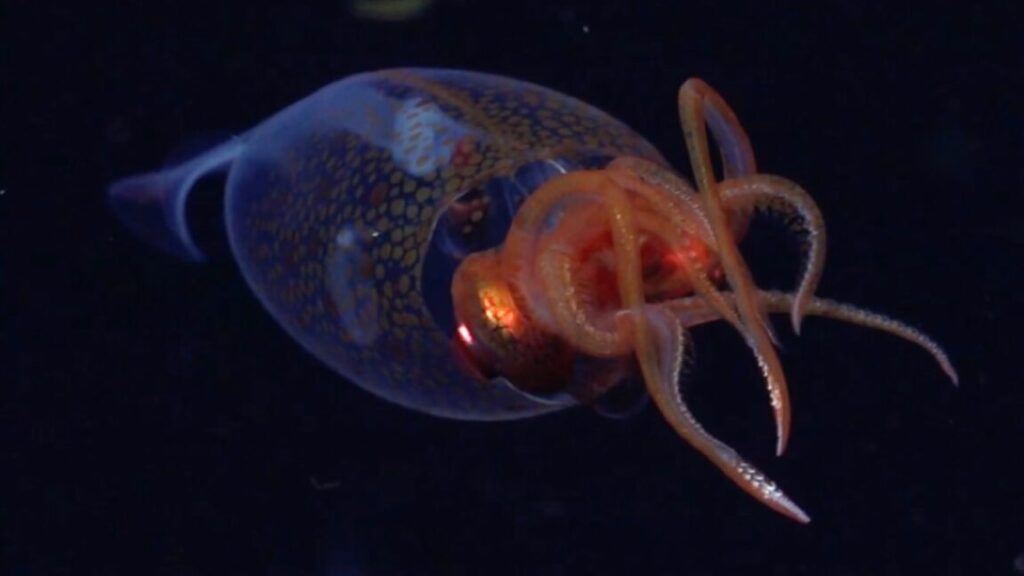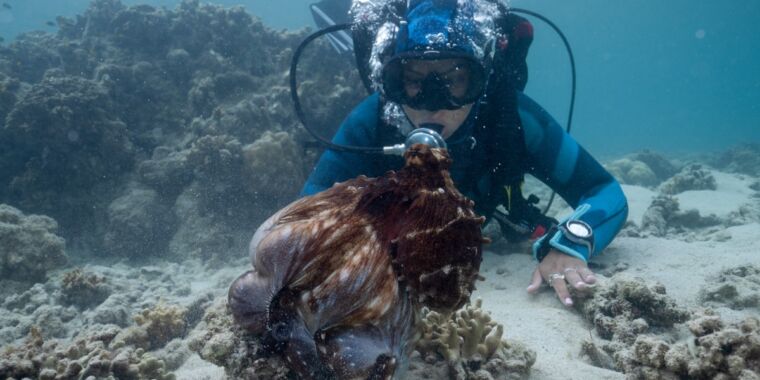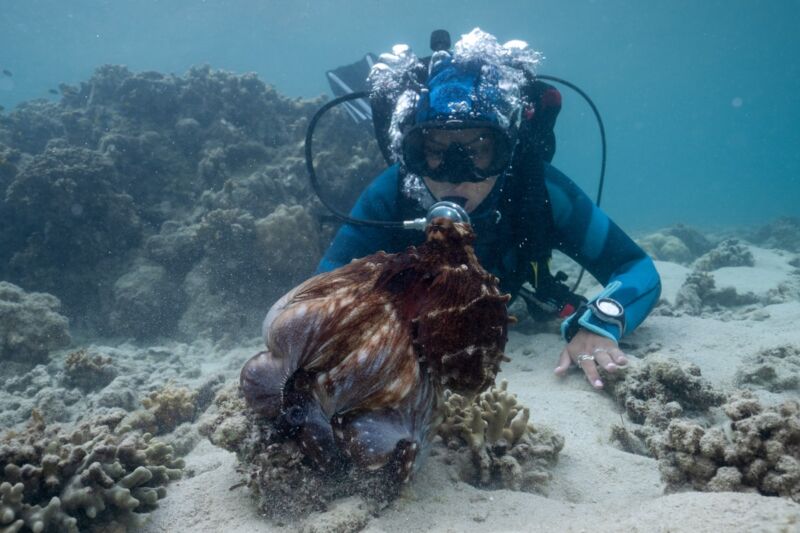Research roundup: Tattooed tardigrades and splash-free urinals
April is the cruelest month
Also: The first live footage of a colossal baby squid; digitally unfolding an early medieval manuscript.
Credit: Schmidt Ocean Institute
It’s a regrettable reality that there is never time to cover all the interesting scientific stories we come across each month. In the past, we’ve featured year-end roundups of cool science stories we (almost) missed. This year, we’re experimenting with a monthly collection. April’s list includes new research on tattooed tardigrades, the first live image of a colossal baby squid, the digital unfolding of a recently discovered Merlin manuscript, and an ancient Roman gladiator whose skeleton shows signs of being gnawed by a lion.
Gladiator vs. lion?
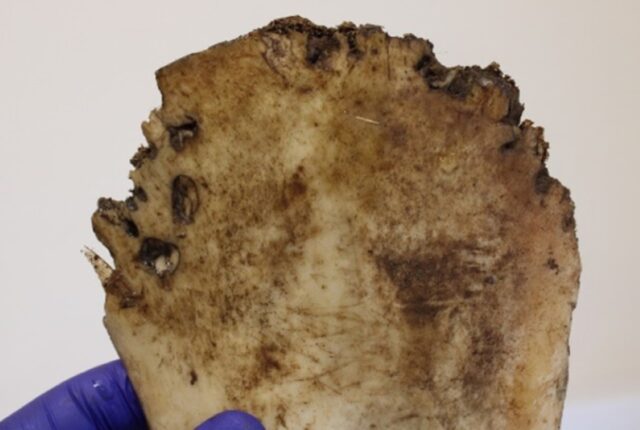
Puncture injuries by large felid scavenging. Credit: Thompson et al., 2025/PLOS One/CC-BY 4.0
Popular depictions of Roman gladiators in combat invariably include battling not just human adversaries but wild animals. We know from surviving texts, imagery, and artifacts that such battles likely took place. But hard physical evidence is much more limited. Archaeologists have now found the first direct osteological evidence: the skeleton of a Roman gladiator who encountered a wild animal in the arena, most likely a lion, based on bite marks evident on the pelvic bone, according to a paper published in the journal PLoS ONE.
The skeleton in question was that of a young man, age 26 to 35, buried between 200–300 CE near what is now York, England, formerly the Roman city of Eboracum. It’s one of several such skeletons, mostly young men whose remains showed signs of trauma—hence the suggestion that it could be a gladiator burial site. “We used a method called structured light scanning [to study the skeleton],” co-author Tim Thompson of Maynooth University told Ars. “It’s a method of creating a 3D model using grids of light. It’s not like X-ray or CT, in that it only records the surface (not internal) features, but since it uses light and not X-rays etc, it is much safer, cheaper, and more portable. We have published a fair bit on this and shown its use in both archaeological and forensic contexts.”
The team compared the pelvic lesions found on the subject skeleton with bite marks from modern animal specimens and concluded that the young man had been bitten by a “large feline species,” most likely a lion scavenging on the body around the time of death. The young man was decapitated after death for unknown reasons, although this was a ritualistic practice for some people during the Roman period. While the evidence is technically circumstantial, “we are confident with our conclusions,” said Thompson. “We’ve adopted a multidisciplinary approach to address this issue and have drawn on methods from different subjects, too. Our use of contemporary comparison zoological material is really what gives us the confidence.”
PLoS ONE, 2025. DOI: 10.1371/journal.pone.0319847 (About DOIs).
Tattooed tardigrades
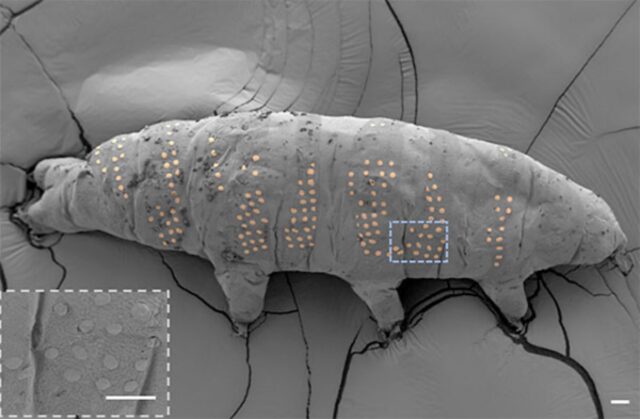
False-colored SEM image of the tardigrade after rehydration and fixation. Credit: American Chemical Society
Tardigrades (aka “water bears”) are micro-animals that can survive in the harshest conditions: extreme pressure, extreme temperature, radiation, dehydration, starvation—even exposure to the vacuum of outer space. Scientists have exploited the robustness of these creatures to demonstrate a new ice lithography technique that can be used to essentially tattoo patterns at the nanoscale on living creatures. They described their method in a paper published in the journal Nano Letters.
Creating precision patterns on living organisms is challenging because the latter require very specific conditions in order to thrive, while fabrication techniques typically require harsh environments—the use of corrosive chemicals, for instance, vacuum conditions, or high radiation. So researchers at Westlake University tested their ice lithography on tardigrades in their dehydrated state (cryptobiosis). Once cooled, the tardigrades were coated with vaporized anisole, creating an ice layer. The team used an electron beam to etch patterns in that layer. Once the creatures were warmed back up, the parts of the ice layer that had not been exposed to the beam sublimated away, and the pattern was preserved on the tardigrade’s surface, even after the creatures were rehydrated.
Granted, only about 40 percent of the tardigrade test subjects survived the full procedure, but further improvements could improve that rate significantly. Once the technique is fully developed, it could enable the fabrication of nanoscale patterns for marking living organisms, such as tracking single cells as they develop or for the creation of sophisticated biosensors.
Nano Letters, 2025. DOI: 10.1021/acs.nanolett.5c00378 (About DOIs).
Holograms that can be grabbed
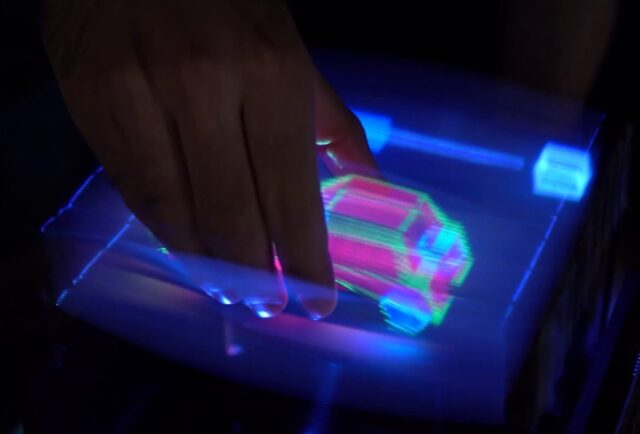
A 3D car is grabbed and rotated by a user. Credit: Iñigo Ezcurdia
A volumetric display consists of scattering surfaces distributed throughout the same 3D space occupied by the resulting 3D image. Volumetric images can be viewed from any angle, as they seem to float in the air, but no existing commercial prototypes let the user directly interact with the holograms—until now. There is a new kind of volumetric display called FlexiVol that allows people to interact directly with 3D graphics displayed in mid-air. Elodie Bouzbib of the Public University of Navarra presented the research at the CHI conference on Human Factors in Computing Systems in Japan this month.
The key lies in a fast oscillating sheet known as a diffuser, onto which synchronous images are projected at high speed (2,880 images per second) and at different heights; human persistence of vision ensures that these images are perceived as true 3D objects. But the diffusers are usually made of rigid materials and hence pose a safety hazard should a user try to reach through and interact directly with the hologram; safety domes are usually employed because of this.
FlexiVol replaces the rigid diffuser with elastic bands that will not permanently deform or twist, distorting the 3D display, and has a different resonant frequency from the volumetric system. The team was inspired by the taxonomy of gestures used with 2D elastic displays and touch screens: swiping, for instance, or pinching in and out to make an image larger or smaller. They tested FlexiVol with a selection of users performing three sample tasks showcasing the ability to manipulate the 3D graphics, such as “grasping a cube between the thumb and index finger to rotate it, or simulating walking legs on a surface using the index and ring fingers,” said Bouzbib.
Look ma, no spashback!
A high-speed video depicting the tests used to measure the critical angle. Credit: Thurairajah et al., 2025
Men, are you tired of urine splashback when you use the loo? Scientists at the University of Waterloo have developed the optimal design for a splash-free urinal, dubbed the Nautilus (aka the “Nauti-loo”). We first covered this unusual research back in 2022, when the researchers presented preliminary results at a fluid dynamics conference. Their final findings have now formally appeared in a paper published in PNAS Nexus.
Per the authors, the key to optimal splash-free urinal design is the angle at which the pee stream strikes the porcelain surface; get a small enough angle, and there won’t be any splashback. Instead, you get a smooth flow across the surface, preventing droplets from flying out. (And yes, there is a critical threshold at which the urine stream switches from splashing to flowing smoothly, because phase transitions are everywhere—even in our public restrooms.) It turns out that dogs have already figured out the optimal angle as they lift their legs to pee, and when the team modeled this on a computer, they pegged the optimal angle for humans at 30 degrees.
The next step was to figure out a design that would offer that optimal urine stream angle for men across a wide range of heights. Instead of the usual shallow box shaped like a rectangle, they landed on the curved structure of the nautilus shell. They conducted simulated urine stream experiments with the prototypes, et voila! They didn’t observe a single droplet splashing back. By comparison, the other urinal designs produced as much as 50 times more splashback. The team did come up with a second design with the same optimal angle, dubbed the Cornucopia, but unlike the Nautilus, it does not fit a range of heights, limiting its usefulness.
PNAS Nexus, 2025. DOI: 10.1093/pnasnexus/pgaf087 (About DOIs).
Colossal baby squid
First confirmed live observation of the colossal squid in its natural habitat. Credit: Schmidt Ocean Institute
In 1925, scientists first described the colossal squid in a scientific paper, based on the discovery of arm fragments in the belly of a sperm whale. This species of squid is especially elusive because it prefers to stay in the deep ocean, although occasionally full-grown colossal squid have been found caught in trawl nets, for instance. One hundred years after its discovery, the colossal squid has now been filmed alive in its deep-ocean home environment for the first time by a team aboard Schmidt Ocean Institute’s R/V Falkor (too) in waters off the South Sandwich Islands.
Colossal squid can grow up to 23 feet long and weigh as much as 1,100 pounds and have distinctive hooks on the middle of their eight arms. Juvenile squid have transparent bodies. It was a baby squid just 30 centimeters long that the team captured on video at a depth of 1,968 feet (600 meters) during a 35-day expedition searching for new marine life; a remote submersible dubbed SuBastian took the footage. The scientists hope to eventually be able to capture an adult colossal squid on camera. The team also filmed the first confirmed living footage of a similar cephalopod species, the glacial glass squid, spotted in the Bellingshausen Sea near Antarctica in January.
Digitally unfolding a Merlin manuscript
Virtual opening of CUL’s Vanneck Merlin fragment.
In 2019, conservationists at Cambridge University discovered a fragment of an Arthurian medieval manuscript that had been repurposed as the cover of a land register document. Written between 1275 and 1315 CE, it was far too fragile to manually unfold, but the university library’s Cultural Heritage Imaging Laboratory has succeeded in digitally unfolding the fragment so that the text can be read for the first time, while keeping the original artifact intact as a testament to archival practices in 16th-century England. Their method could be used to noninvasively study fragile manuscript fragments held in other collections.
The team used a combination of CT scanning, multispectral imaging, and 3D modeling, as well as an array of mirrors, prisms, magnets, and other tools to photograph each section of the fragment. In this way they were able to reconstruct and virtually unfold the manuscript, revealing the text. Scholars had originally thought it was a text relating to Sir Gawain in Arthurian lore, but it turned out to be part of a French language sequel to the King Arthur legend called the Suite Vulgate du Merlin. There are only 40 known surviving manuscripts of this work. One section concerns Gawain’s victory over Saxon kings at the Battle of Cambenic; the other is a story of Merlin appearing in Arthur’s court disguised as a harpist on the Feast of the Assumption.
Jennifer is a senior writer at Ars Technica with a particular focus on where science meets culture, covering everything from physics and related interdisciplinary topics to her favorite films and TV series. Jennifer lives in Baltimore with her spouse, physicist Sean M. Carroll, and their two cats, Ariel and Caliban.
Research roundup: Tattooed tardigrades and splash-free urinals Read More »
